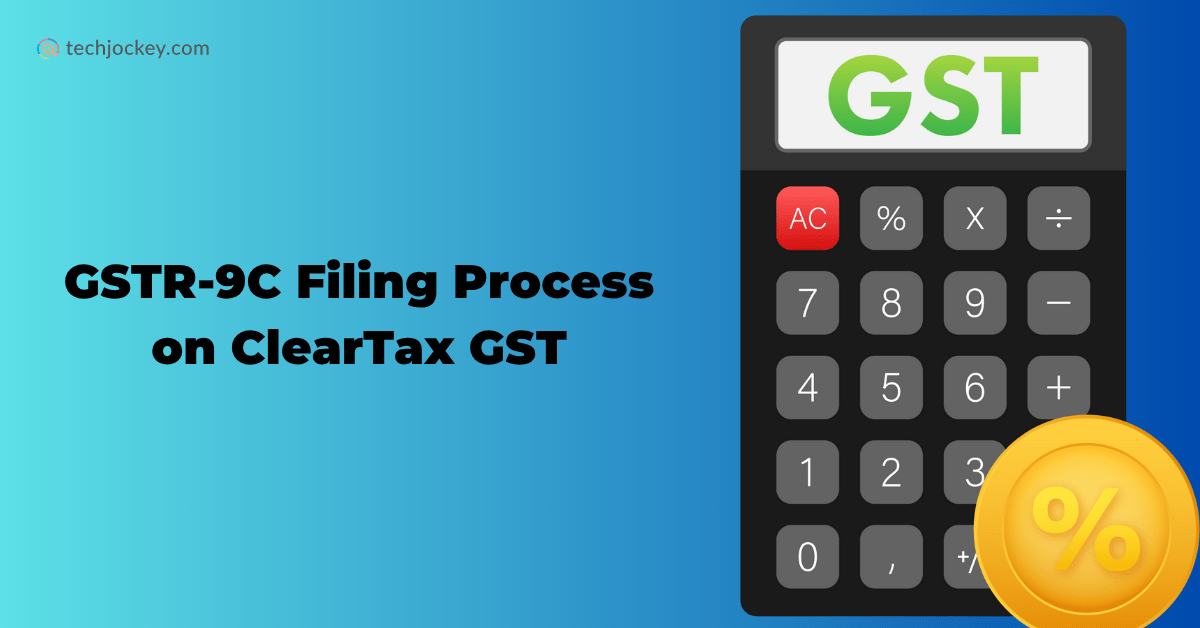
Filing GST returns each year is a must for registered taxpayers in India. But if your company earns more than INR 5 crore annually, then filing GSTR-9C becomes mandatory. GSTR-9C is a reconciliation statement, and it ensures that the data you submit to the GST portal aligns with your audited books of accounts.
Owing to this, a significant number of businesses use automated GST Software like ClearTax to save time and avoid mistakes. The GSTR-9C filing process on ClearTax is reliable, fast, and easy, even for first-time filers.
So, let’s learn how to file the GSTR-9C return online with ClearTax. While at it, let’s also get a detailed walkthrough of GSTR-9C return steps on ClearTax and the top benefits of filing GSTR-9C via ClearTax.
GSTR-9C is an annual return reconciliation form required under the GST Act. It matches the figures in your filed GST returns (like GSTR-9) with your audited financial statements.
If your turnover exceeds INR 5 crore in a financial year, filing GSTR-9C is mandatory. It confirms…
Earlier, this form had to be certified by a Chartered Accountant. Since FY 2020-21, it only requires self-certification, but it still needs to be accurate.
To help with this, most companies now prefer using tools like ClearTax. The platform makes the entire process, from reconciliation to filing, easy. The built-in ClearTax GST reconciliation tool makes sure that the numbers match, and issues get flagged clearly.
Suggested Read: What is GSTR-9C? A Complete Guide
Now let’s walk through the GSTR-9C filing process on ClearTax. This is the smart way to handle your filing in less time with fewer errors.
The GSTR-9C return steps on ClearTax include the following…
Step 1: Go to www.cleartax.in and sign in to your account.
Step 2: Choose the relevant GSTIN from your business dashboard. Ensure that you’ve already filed your GSTR-9, because you can only begin GSTR-9C filing after that is complete.
Step 3: Using the ClearTax GST reconciliation tool, import GSTR-1, GSTR-3B, and GSTR-9 data directly from the GST portal
Step 4: Once data is uploaded, the system will automatically match turnover, tax paid, and input tax credit (ITC), showing mismatches side-by-side for review. All calculations follow the official GSTR-9C format in ClearTax.
Step 5: You’ll see the GSTR-9C format in ClearTax pre-filled using your imported data. Review each section, including:
If there are differences between books and GSTR returns, you are required to explain them. You can enter clarifications, remarks, or supporting documents, all inside the platform.
ClearTax GST
Starting Price
Price on Request
Step 6: Upload supporting documents, including…
Step 7: Once verified, click Generate GSTR-9C JSON. This file format is required to upload your return to the official GST portal.
Advanced users usually take this step further and upload GSTR-9C JSON on ClearTax once more for final verification. This lets them double-check before heading to the portal.
Step 8: Now, upload the JSON to the GST portal and the file return. You can refer to our blog to know how to accomplish this in detail.
Step 9: Submit and e-Sign (using DSC or Aadhaar OTP)
Once filed, you can download the filing acknowledgment for your records. That’s how easy it is to complete the GSTR-9C return steps on ClearTax!
There are major advantages to managing your filing through ClearTax. Here are the top benefits of filing GSTR-9C via ClearTax…
ClearTax GST
Starting Price
Price on Request
Conclusion
Filing GSTR-9C does not need to be a cause of stress. Whether you are a small business or a large company with multiple GSTINs, the GSTR-9C filing process on ClearTax will save you time and reduce compliance risk.
From importing data, reconciling with your books, reviewing your return, and uploading to the GST portal, every step is built right into the software. What else does a taxpaying business in India need?
So, get in touch with the Techjockey team and get your hands on the ClearTax GST software today itself!
Android trojan, for the unversed, is malware that poses a serious threat to mobile… Read More
Smartphones have completely transformed how we bank, making money transfers and payments quicker and more… Read More
Ever come across an AI chatbot giving weird medical tips? Or one, as hiring… Read More
Recruiting now does not occur over table-it mostly begins on a screen. This has… Read More
Did you know approximately two-thirds of total organizations who use generative AI have deployed it… Read More
How would you feel if your organization was under attack and you had no idea… Read More